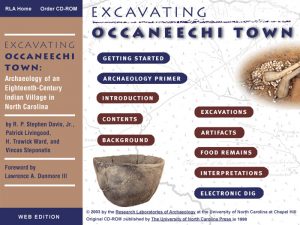Excavating Occaneechi Town

Welcome to an online archaeological site report!
What was Occaneechi Town?
Occaneechi Town, also known as the Fredricks site, was a small but important 18th-century village of the Occaneechi tribe that still exists today. The tribe’s village was on the banks of the Eno River in North Carolina. Archaeologists from the University of North Carolina at Chapel Hill started excavating Occaneechi Town because they wanted to learn more about how Native Americans were affected by European colonization.
Why “Excavating Occaneechi Town?”
Archaeologists wanted to describe and explain the buried remains of what they found over the course of the excavation in an accessible and interactive way, so they created the online site report Excavating Occaneechi Town. The report contains visual and descriptive information that you do not usually get to experience in a typical archaeological site report. It is a complete, fully searchable record of all the excavated contexts and recovered artifacts from Occaneechi Town with 1,000+ full-color photographs and maps, and information on 100,000+ analyzed artifacts! The report also contained an archaeological teaching tool, called the “Electronic Dig,” where you could design your own research strategies and virtually re-excavate Occaneechi Town.
Behind the Scenes: The technical stuff
This project was part of a proposal to IBM in 1993 to create program called Documenting the American South. During the development of the original CD for Excavating Occaneechi Town, the production team thought carefully about the accessibility of the information as well as the longevity of the project. Given the rapid turnover of technology, the team decided to create an HTML version that could be used with any standard web browser. In order to avoid as many issues as possible with backwards compatibility, the project has maintained the original format as much as possible, using only the most basic HTML tags and avoiding any “bells and whistles.” The one exception was the “Electronic Dig” teaching tool, which was created using Javascript. Unfortunately, this is the one aspect of the project that no longer works; the team hopes to get funding to update the Electronic Dig so that it will be accessible via the web again. Otherwise, the text remains essentially the same as the first edition.
Want to learn more?
You can watch video clips of the archaeological dig in the Video Gallery and explore a summary of the Fredricks site on this website.
